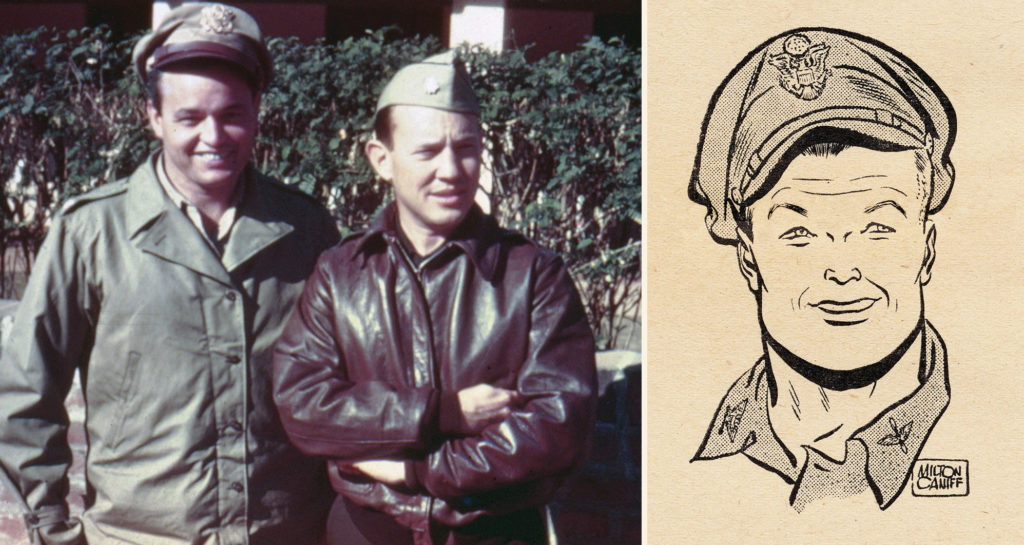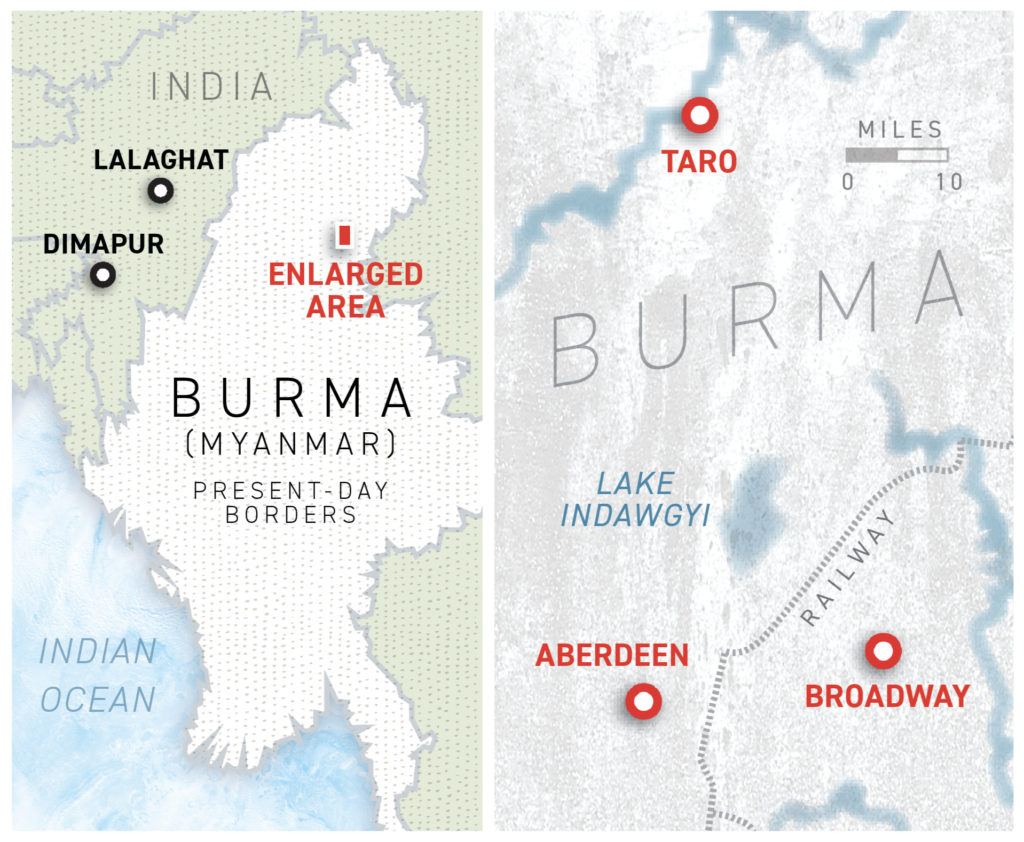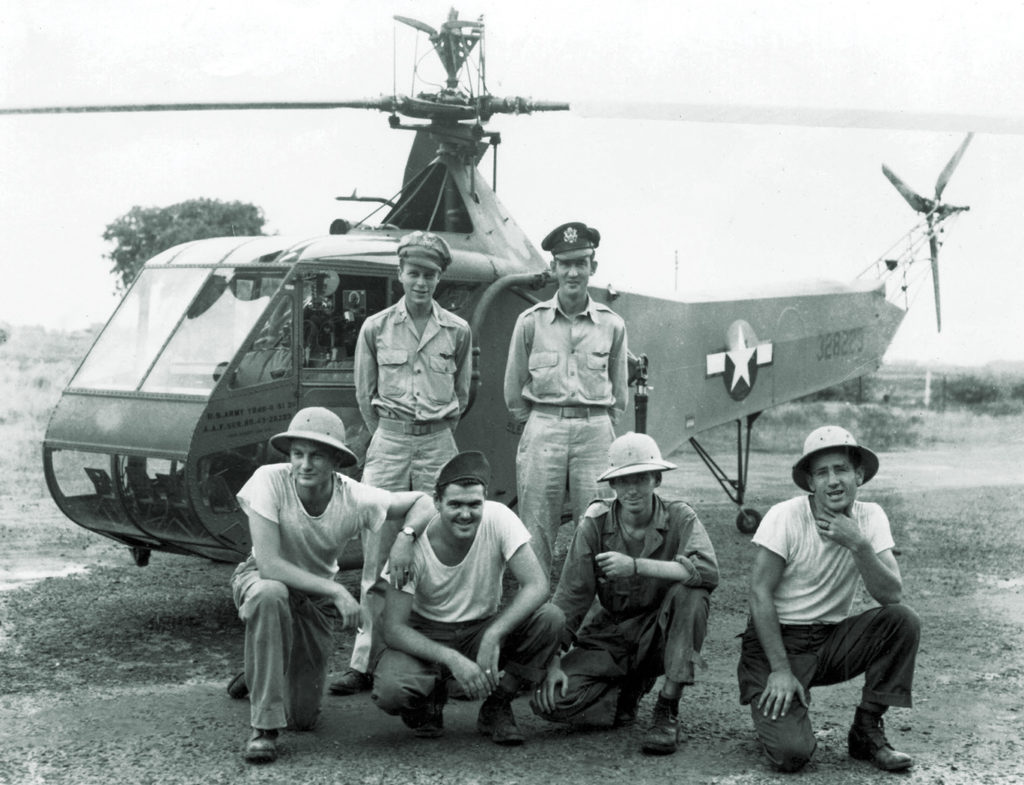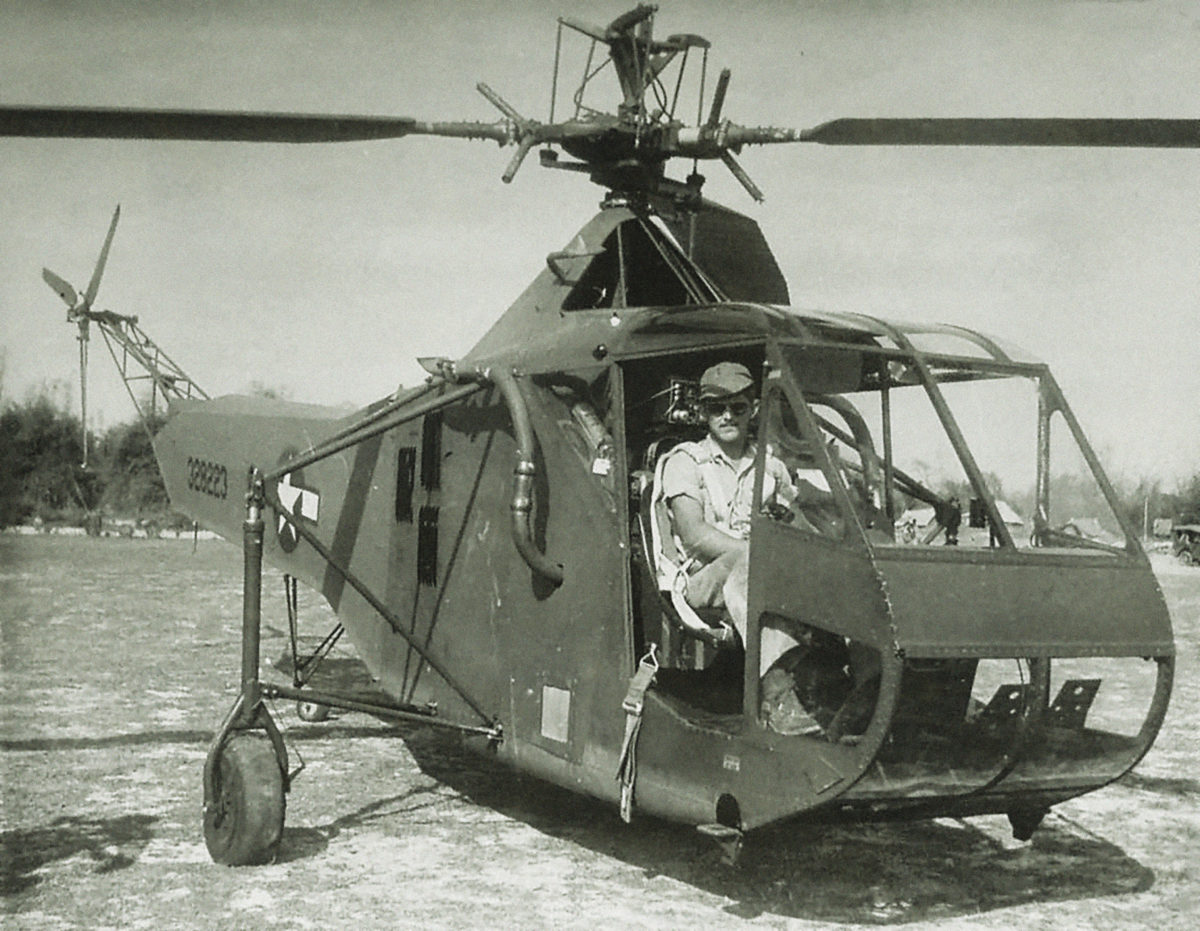Second Lieutenant Carter Harman was grounded, nursing a cold, and leafing through a Life magazine. It was 1943 and the Brooklyn-born Princeton graduate, an aspiring musician and composer, was serving as a flying instructor at Perrin Air Force Base in Texas while waiting to be shipped overseas. An officer approached the rail-thin Harman and several other young pilots. He asked if there was anyone who weighed less than 150 pounds who would volunteer to fly “heel-e-o-copters.”
“I had heard about them, but I knew nothing about helicopters,” Harman said years later. “I asked around and someone told me that even though you should never volunteer for anything in the Army, it was a good idea to get into every kind of aircraft I could. So, I volunteered.”
Just six months later, Harman was above the jungles of Burma (now Myanmar) flying the first military helicopter rescue mission with an underpowered Sikorsky YR-4B that was prone to stalling in the hot and humid climate. Below him, hiding from the Japanese in the thick jungle canopy, was an American pilot, Ed “Murphy” Hladovcak, who had been shot down while ferrying three wounded and sick British soldiers in a Stinson L-1 Vigilant light aircraft. Enemy patrols passed so close to the four men that, “we could have reached out and touched them,” said Hladovcak, whom everyone called Murphy because his last name was hard to pronounce.
The origins of Harman’s mission can be traced back to the 1943 Quebec Conference of Allied leaders, which adopted a bold plan (eventually called Project 9 or Operation Thursday) to establish airbases deep within enemy territory in Burma to support the British Special Forces of Maj. Gen. Orde Wingate—the Chindits—who were operating behind enemy lines. The Americans would provide the air support for the operation, and General Harold H. “Hap” Arnold selected Lt. Col. Philip Cochran and Lt. Col. John Alison to lead the newly formed 1st Air Commando Group to operate the bases. Cochran was a friend of well-known cartoonist Milton Caniff and served as the inspiration for Flip Corkin, a flight instructor in Caniff’s Terry and the Pirates comic strip. He had just returned from service in North Africa when he received his assignment. Alison was back in the U.S. after flying P-40s in China when he received his orders.
While Cochran and Alison were planning Project 9, Harman spent the last few months of 1943 at Sikorsky’s plant in Bridgeport, Connecticut, where he and several other volunteers learned how to fly helicopters. At the time, the new invention was untested on the battlefield. Igor Sikorsky’s VS-300, considered by many to be the world’s first successful helicopter, had initially flown in 1939, and it led to the YR-4A, production of which began in late 1942. The YR-4B that Harman would fly was an improved version with a 200-horsepower engine, about 20 more than the YR-4A’s. Under ideal conditions, it had a top speed of around 65 miles per hour and could carry its pilot and a passenger about 120 miles. The jungles of Burma were hardly ideal conditions, and it took Cochran and Alison a long time to convince their superiors to include six of the helicopters on their roster of aircraft.

Harman remembered watching his first helicopter flight at Bridgeport. Charles Lester “Les” Morris, Sikorsky’s famed test pilot, was at the controls. “What have I gotten myself into?” Harman asked himself as he watched the YR-4B take to the air.
He found out a few days later on his first flight, with Sikorsky test pilot Dimitry D. “Jimmy” Viner flying. “I was astonished that we lifted right up and went right over a fence in front of us,” he recalled. “When we came in for a landing, being a fixed-wing pilot, I kept checking the airspeed to make sure we wouldn’t come in too slow and stall or too hot and roll off the end of the runway. The speed went down to 40, 30, 20, 10 and I was terrified. I knew it was supposed to hover before it landed, but you really don’t understand this until you are there.”
Learning how to hover was difficult. “You’d go sideways and correct, but overcorrect, and pretty soon you were overcorrecting back and forth,” Harman said. “The instructor would take the stick and stop it and then you’d try it again.”
Harman soon got the hang of hovering, as well as takeoffs and landings. After 2.5 hours of dual flight with a Sikorsky test pilot beside him, he became the seventh Army pilot to solo in a helicopter. He completed his training after 20 hours of solo flight, and then was on his way overseas along with three other helicopter pilots and six dismantled YR-4B helicopters loaded aboard C-46 transports. For two weeks the convoy wound its way from Bridgeport to Miami, Puerto Rico, Venezuela, Brazil, Ascension Island in the South Atlantic, Egypt and, finally, Lalaghat, India, arriving on March 10, 1944. “Of the six helicopters that took off with us, only four got there,” Harman said. One of the C-46s crashed in a storm and its helicopter was destroyed. Another arrived with a missing tail rotor that was never located.
Five days earlier, on March 5, a fleet of C-47s had left Lalaghat, towing scores of Waco CG-4 Hadrian gliders about 200 miles into Burma to launch Project 9. The gliders, loaded with bulldozers, mules, troops and supplies, landed late at night in a jungle clearing dubbed Broadway. Although most of the gliders were damaged or destroyed, “539 men and almost 30,000 pounds of supplies successfully landed in the clearing,” according to an account by Defense Media Network. The men built a landing strip, and a fleet of North American B-25 Mitchell bombers, P-51 Mustang fighters and Stinson L-1 and L-5 light aircraft set up shop to ferry in additional troops and supplies, provide air cover, fly bombing missions, evacuate wounded soldiers and otherwise support the Chindits.
The operation took the Japanese by surprise, and they didn’t discover the Broadway base for a few days. Once they did, the fighting intensified, and more and more evacuation flights, in fixed-wing aircraft, began using the base.
Back in Lalaghat, the helicopters were put together and a series of test flights began. On one of these test flights, Burt Powell and Pete Tierney were flying a YR-4B when it hit a power line and crashed, killing Powell and seriously injuring Tierney. Bob Beaman, the third helicopter pilot, was shot in the hip while flying a fixed-wing mission. This left Harman as the only healthy YR-4B pilot.

The original plan was to fly the helicopters 200 miles east from Lalaghat to Broadway, but geography and the Japanese made this a challenge. “I had about two hours of fuel at 60 miles per hour,” Harman remembered. “The Japanese held the area so there was no way we could land to refuel.” One alternative was to fly 600 miles north to an Allied airstrip at Taro in northern Burma, refueling at stops along the way, and then fly another 250 miles south, with refueling stops, to another base called Aberdeen. “It was over Japanese territory, and I didn’t want to take a chance, Harman said. “So it looked like we weren’t ever going to have a mission.”
That changed on April 21, 1944, when “Murphy” Hladovcak was evacuating three Chindits from 200 miles behind enemy lines. Two of the soldiers were wounded and the third had malaria. Ground fire hit the fuel line of Hladovcak’s L-1. The American pilot was able to find a small clearing, about 150 feet long, and land beside a Japanese-held road. The men headed off into the jungle and began climbing to the top of a small ridge. It was a difficult climb, made even harder by the injuries and illness of the Chindits. Hladovcak knew the Japanese did not have aircraft in the area, so he spread out a parachute at the top of the ridge to help American pilots find them. An Allied pilot did spot the men and reported their location to headquarters. Japanese patrols controlled the area, ruling out a ground rescue, and the thick jungle made an airplane rescue impossible. There was one other option: A helicopter could, in theory, reach the men from Broadway and ferry them out, one-by-one.
Eventually, another pilot flew over and dropped a note. “They said a helicopter was coming to get us,” Hladovcak said later.
“Send the eggbeater to Taro,” was the message Harman received in Lalaghat. From Taro, Harman would fly on to the Broadway base and receive further instructions for the rescue.
Harman and Jimmy Phelan, a Sikorsky mechanic assigned to help maintain the helicopters, began preparing one of the YR-4Bs for the rescue mission. They loaded the cockpit with extra cans of gasoline and strapped a stretcher to one of the skids. “It looked like a coffin,” Harman said. “[The stretcher] was right in the middle of the downwash and as far as flying, it created some drag. I had to counteract it a bit to keep flying straight.”
Flying straight was just one of the many issues Harman had to address. The temperature was above 100 degrees, sometimes reaching 110. This reduced the payload the YR-4B could carry and caused the engine to stall. “We found with some tests that if we got it moving forward, getting more air into the engine, it wouldn’t stall,” Harman said. “Well, the jungle was too dense to do running starts. So, we decided we would jump start it in the air. We would over rev it, get it up to the red part of the gauge, and then pull the main pitch up very hard and jump into the air. Then, I had to convert to forward flight right away. It was hazardous, but we could lift two people that way.”
Harman first had to fly to a base in Dimapur to refuel, unsure if it was still held by the Allies. “We didn’t know if the Japanese had gotten there, the details were sketchy,” he said, but to his relief, the Allies still held the base. It took Harman and the YR-4B two days to get from there to Taro, where he was told to continue to Broadway. Harman didn’t think he could do it. It was too far to fly without refueling and he didn’t want to land and refuel in Japanese-held territory. He was told to land near Lake Indawgyi and refuel there with the extra gas tanks he was carrying. The briefers said there would be time to refuel before any Japanese troops arrived.
Harman was skeptical. Instead, he and some mechanics used good-old Yankee ingenuity to rig an auxiliary gas tank from a crashed L-1 into the helicopter cockpit, just above the pilot’s head. By the time the tank was in place, it was dark, and Harman had to spend the night in Taro. He was in luck: The Heavenly Body, starring Hedy Lamarr and William Powell, was playing at the base that night.

The final leg to Broadway was over Japanese-held territory where Harman could be spotted from the ground, or possibly by a fighter. Harman decided to fly at about 1,200 feet, high enough to be above the range of enemy ground fire. “I also figured out what to do, theoretically, if I was attacked by a fighter,” he said. “Since I was able to stop or go slow, and was more maneuverable, I would peel off and head for the jungle and hide in the trees.” Fortunately for Harman, he didn’t encounter ground fire or a Japanese fighter.
After reaching Broadway on April 24, Harman took Cochran up in the helicopter. The engine quit and the pilot had to autorotate to a landing. Nevertheless, the YR-4B impressed Cochran. In a letter to a friend, he wrote that, “Today the ‘egg-beater’ went into action and the damn thing acted like it had good sense.”
In the meantime, Hladovcak—who was about 40 miles away from Broadway—had his hands full caring for the three British soldiers. With limited rations and only a small first aid kit, he put sulfa on the open wounds and cut bandages from the parachute. Soon after Harman reached Broadway, another pilot dropped a note from his airplane to Hladovcak. Head back down the ridge, it said, and find a clearing. The helicopter is coming.
On April 25 Harman first flew to a river that had a sandbar large enough for L-5s to land. From there a pair of L-5s led Harman and the YR-4B to Hladovcak and the three British soldiers. Harman circled until he found a flat, clear spot to land. “I saw Murphy come out of the jungle limping,” Harman said. “He had banged up his knee and elbow carrying this guy down on his back.”
“You look like an angel,” Hladovcak told Harman.
The wounded soldier had a serious back injury, smelled of dry blood and was covered in flies. They loaded him into the helicopter. “I made a jump start and made it back to the sandbar,” Harman said. The wounded man was loaded into an L-5 waiting there.
Harman returned to the clearing, picked up a second British soldier and ferried him to the sandbar. And then the YR-4B’s overheated engine refused to restart. It was getting dark, so Harman and the others at the sandbar decided to wait until the next morning to pick up Hladovcak and the other wounded Chindit.
By this time Japanese soldiers had become aware of the rescue mission and a search party of soldiers began looking for Hladovcak and the remaining British soldier. “We heard them walking all around us,” Hladovcak said. “We didn’t sleep the entire night.”
The next morning, a brief rain shower lowered the temperature, the YR-4B’s engine started back up, and Harman returned to the clearing and picked up the third British soldier, and then returned to bring Hladovcak out. Harman and his eggbeater had completed the mission.
Harman flew a handful of what he called “routine” casualty evacuation missions from the Aberdeen base over the next few weeks. He saw Hladovcak a few times “but we really didn’t know each other,” Harman said, adding that the British soldier with the back injury survived.
With monsoon season approaching, Harman received orders to fly the YR-4B the 600 miles back to Lalaghat, and then ferry the two remaining helicopters—the third one had been destroyed in a crash with Tierney at the controls, but he wasn’t seriously injured—to a base in Asansol, India, northwest of Calcutta. “I had to stop several times in paddy fields to wait out the terrible storms,” Harman said. “The locals always rushed out to see what was going on.” Sometimes as many as 1,000 people crowded in for a look at this strange flying machine. Harman had one engine failure on the ferry flights, the first in-air failure he had experienced in a YR-4B. Fortunately for all concerned, the helicopter was only four or five feet off the ground.
At the base in Asansol, Harman “checked out” a few fixed-wing pilots in an YR-4B. He then got a bad case of dysentery and spent almost a month in the base hospital. By then monsoon season had arrived. “That was the end of the helicopters,” Harman said. “They were stored in Asansol and I was part of a light-plane squadron,” adding that, “so far as I know, the two remaining YR-4Bs were abandoned in India.”
In the decades after the war, Hladovcak became a civilian flight instructor and a licensed helicopter pilot. The Nebraska native was involved in airport operations, operated Antelope Flying Service and ran a tavern.
Harman was discharged in August 1945 with the rank of captain and returned to New York. Over the ensuing decades, he was a music reporter for the New York Times, a music editor at Time magazine and the author of A Popular History of Music: From Gregorian Chant to Jazz (1956). He composed his own music and started a recording production company. Harman’s heroics in Burma received minimal media coverage at the time and seemed to be a lost chapter of World War II aviation history.
And then, Harman and Hladovcak were invited to the 1986 annual meeting of the Helicopter Association International in Anaheim. “At first, I was a little reluctant to go,” Hladovcak said. “I didn’t look forward to seeing Carter as an old man. But you know what, he still looked pretty good.” In fact, Hladovcak joked, Harman still looked like an angel. Articles in the Orange County Register and Vertiflite magazine sparked renewed interest in their story. They would not be forgotten.
Hladovcak died in 1992 at the age of 71. Harman passed away in 2007. He was 88. The obituary that ran in the New York Times stated his “breadth of interests led him to write profiles of jazz greats Duke Ellington and Rosemary Clooney while composing his own operas and symphonic works, and to write a children’s book about skyscrapers at a time when he was also producing recordings of avant-garde music.” The story did not mention his experiences flying an eggbeater on a rescue mission in Burma.





